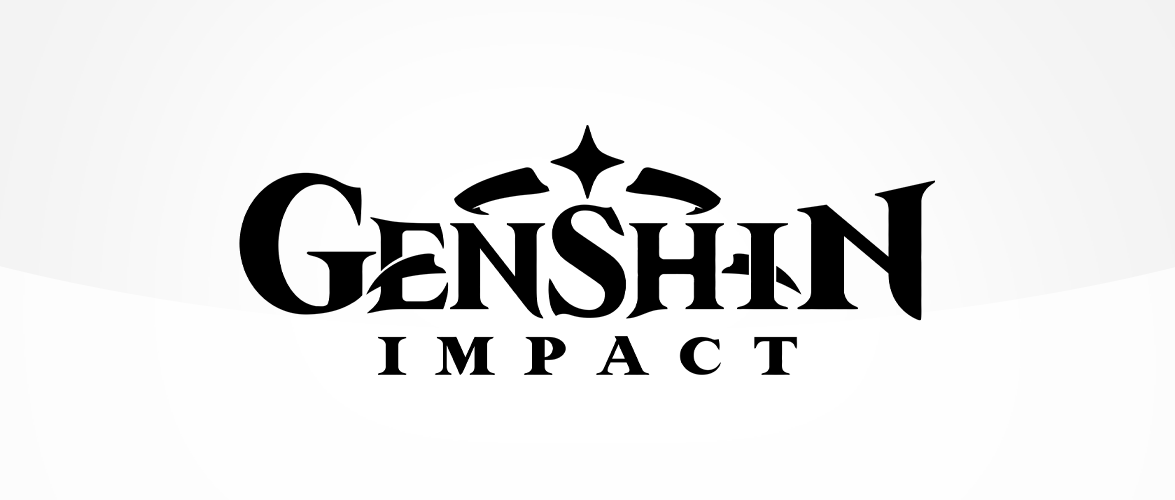Project Overview
- Task: The project involved a multi-stage process, including deep-dive feature proposals, comparative D1 retention analysis, and the conception of new systems to address core player pain points. Key tasks included creating user flowcharts, wireframes, UI art mockups, and detailed feature proposals.
- Tools: Figma, Adobe Illustrator, Adobe Photoshop.
- Project Length: This body of work was developed over a 7-week course period, spanning multiple assignments.
- Challenges: A primary challenge was addressing the cognitive overload faced by new players in systems-heavy games. A further challenge was designing intuitive solutions for complex endgame problems, such as character optimization and inefficient quest management, requiring a deep understanding of player psychology and existing game mechanics.
My Roles & Responsibilities
- UX Researcher: Analyzed the Day 1 new player experience to identify pain points and opportunities for improvement
. - UX/UI Designer: Created user flows, wireframes, and UI mockups for new feature proposals, including a "One-Click Optimal Build" system and quest management tools.
- Product Strategist: Evaluated feature proposals based on usability, desirability, and feasibility, and defined success metrics to measure their impact
.
Work Process & Methodology
Journey Analysis
Brainstorming & Prioritization
and UI Mockups
Project Highlights
- Focused Feature Proposal: The process began with a deep dive into a specific endgame pain point in Genshin Impact—character gearing—leading to a complete feature proposal from concept to mockup.
- D1 Retention Analysis: A formal comparative analysis of the first 90 minutes of gameplay for both Genshin Impact and Call of Duty: Mobile was conducted to identify strengths and weaknesses in the new player onboarding process.
- Problem Identification & Prioritization: Key issues identified in the analyses were prioritized using a gold, silver, and bronze tier system to focus on the most impactful changes.
- Solution Design & Prototyping: The concepts were translated into tangible design artifacts, including flowcharts, wireframes, and high-fidelity UI mockups, to visualize the proposed solutions and user interactions for the final portfolio.
Challenges
- Reducing Cognitive Overload: A key challenge was addressing the cognitive overload new players face when confronted with numerous complex menus and meta-systems too early in their gameplay experience
. - Designing for Complex Systems: Creating an intuitive "One-Click Optimal Build" required designing a solution for a highly complex backend algorithm that must scan and correctly weigh a vast combination of items and stats.
- Improving Existing UI Scalability: The current quest log in Genshin Impact is straining under the sheer volume of content, presenting the challenge of redesigning the UI to manage a long and growing list of quests without overwhelming the player.
Player Journey Analysis: Key Findings
- Key Problem Identified: Cognitive Overload
In both games, the new player journey is significantly hampered by cognitive overload
- Key Strength Identified: A Powerful Core Experience
The analysis also revealed that both games excel at creating a strong initial emotional hook, which is a critical asset for player retention
From Problems to Solutions: Feature Brainstorming & Prioritization
- Step 1: Brainstorming & Ranking
The process began by listing all potential features and improvements on sticky notes. Key ideas included "Implement Region Filters for World Quests," "Add a Search Bar," and "Display Clearer Prerequisite Information". These ideas were then ranked in order of importance to create an initial priority list.
- Step 2: The Gold/Silver/Bronze Prioritization Method
To create a practical and strategic development plan, the ranked features were categorized using the Gold/Silver/Bronze approach. This methodology defines the scope of the proposed features in three tiers:
Gold/Silver/Bronze Prioritazion Method
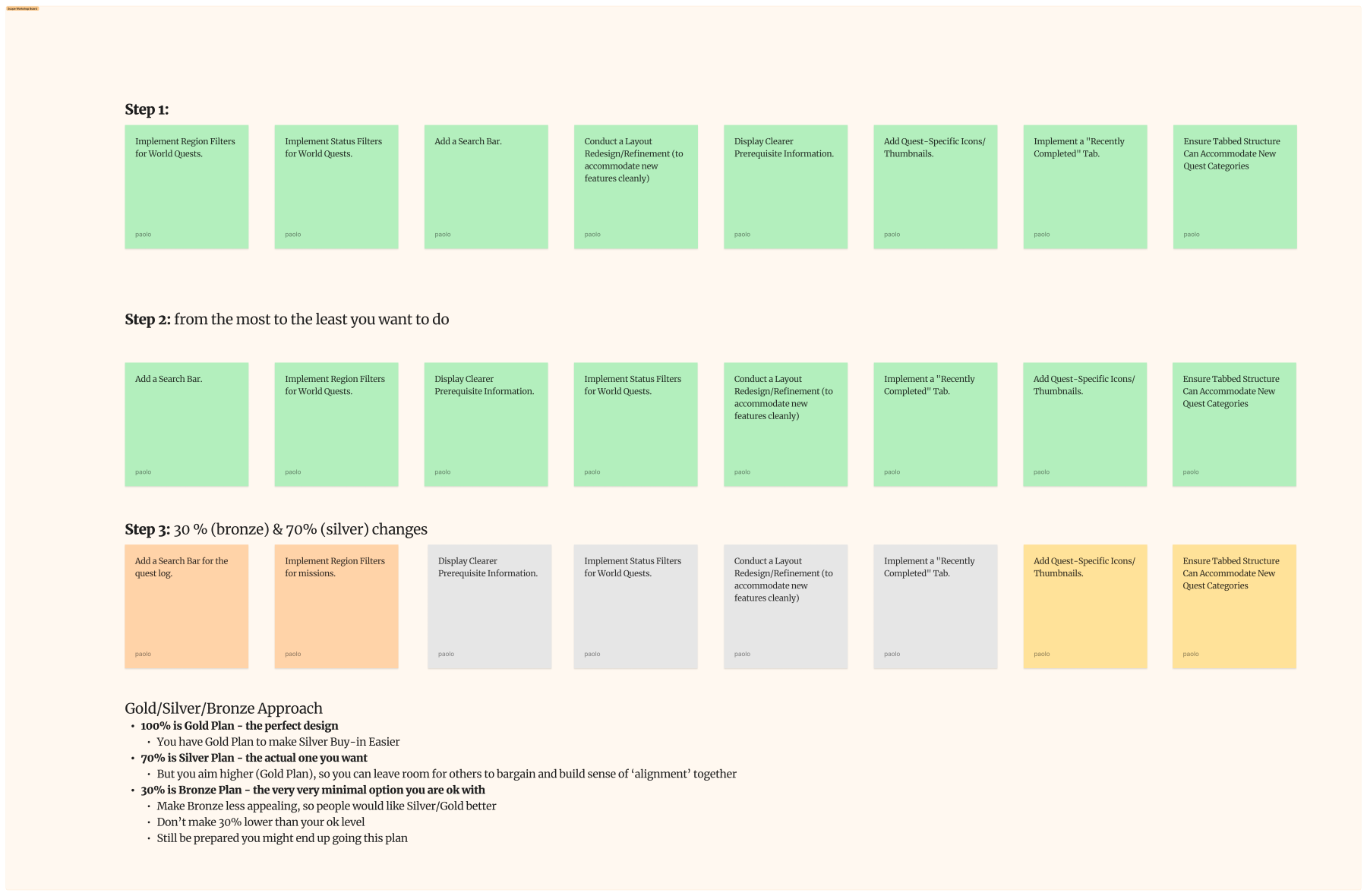
Case Study 1: Character Customization Feature Proposal
This project, "One-Click Optimal Build," is a feature proposal designed to solve a major point of friction in Genshin Impact's endgame: character optimization
Pain Point: Complex and Time-Consuming Character Gearing
Character optimization is a core part of the Genshin Impact endgame, but it is also a significant barrier. Players, especially those less familiar with complex stat interactions, struggle to manually compare hundreds of items (artifacts and weapons) to find the best build for each character, leading to frustration and inefficient play.
Proposed Solution: "One-Click Optimal Build"
This feature introduces a smart "Equip Best" button on the character screen.
- Usability & Desirability: Players can instantly equip their characters with the strongest available items with a single click. The system provides a clear "Before vs. After" stat comparison, allowing players to make an informed decision and feel an immediate, gratifying power increase.
- Functionality: A sophisticated backend algorithm scans the player's inventory, weighs stats and set bonuses based on pre-defined profiles for each character, and presents the optimal combination.
UI Mockups
- Comparison Screen: The system presents a clear before-and-after comparison of key stats, empowering the player to make an informed choice.
- Confirmation: Upon confirmation, a simple message affirms that the optimal build has been successfully applied.
Flow-chart and UI Mockups for the Character Customization Screen

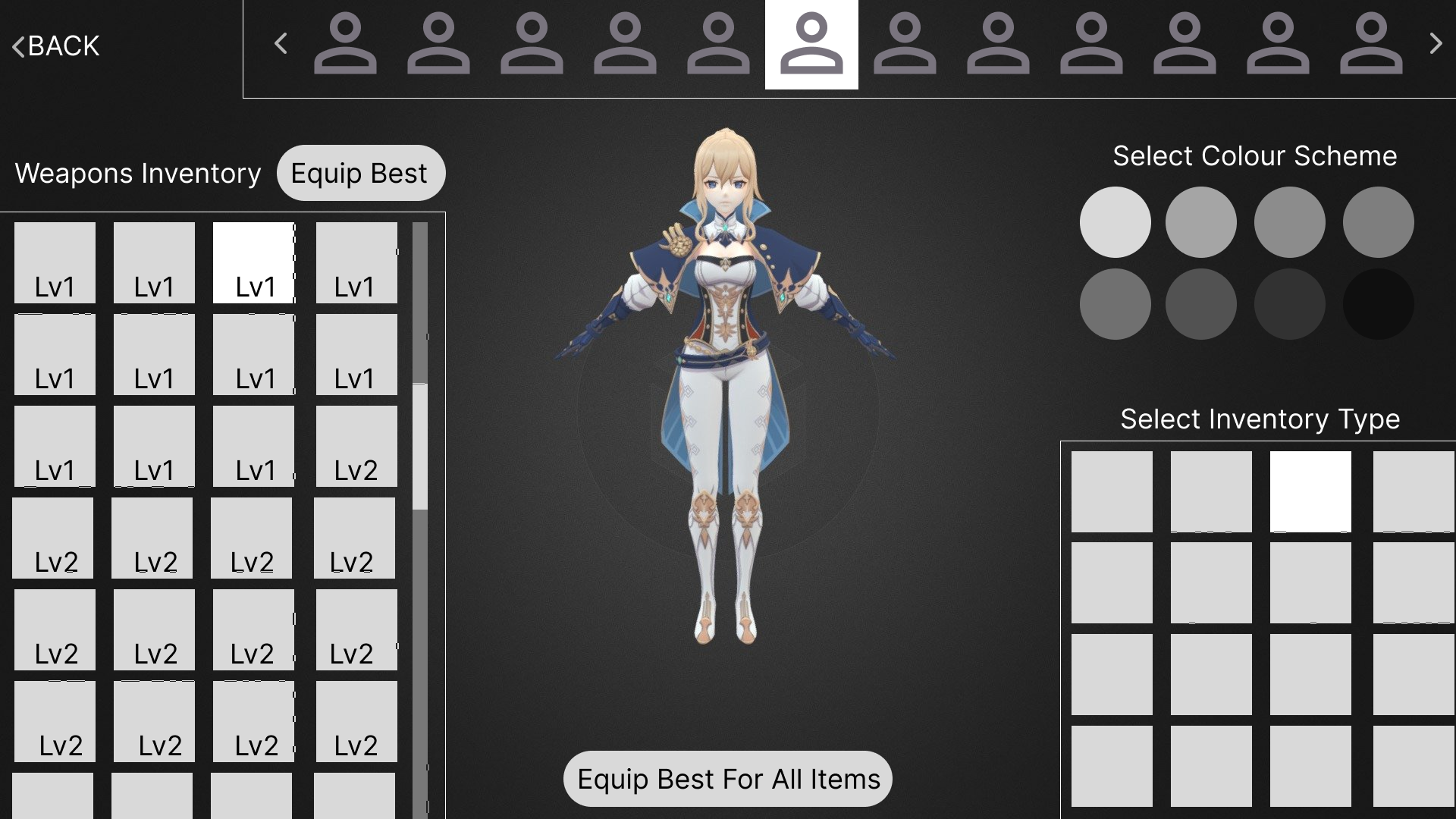
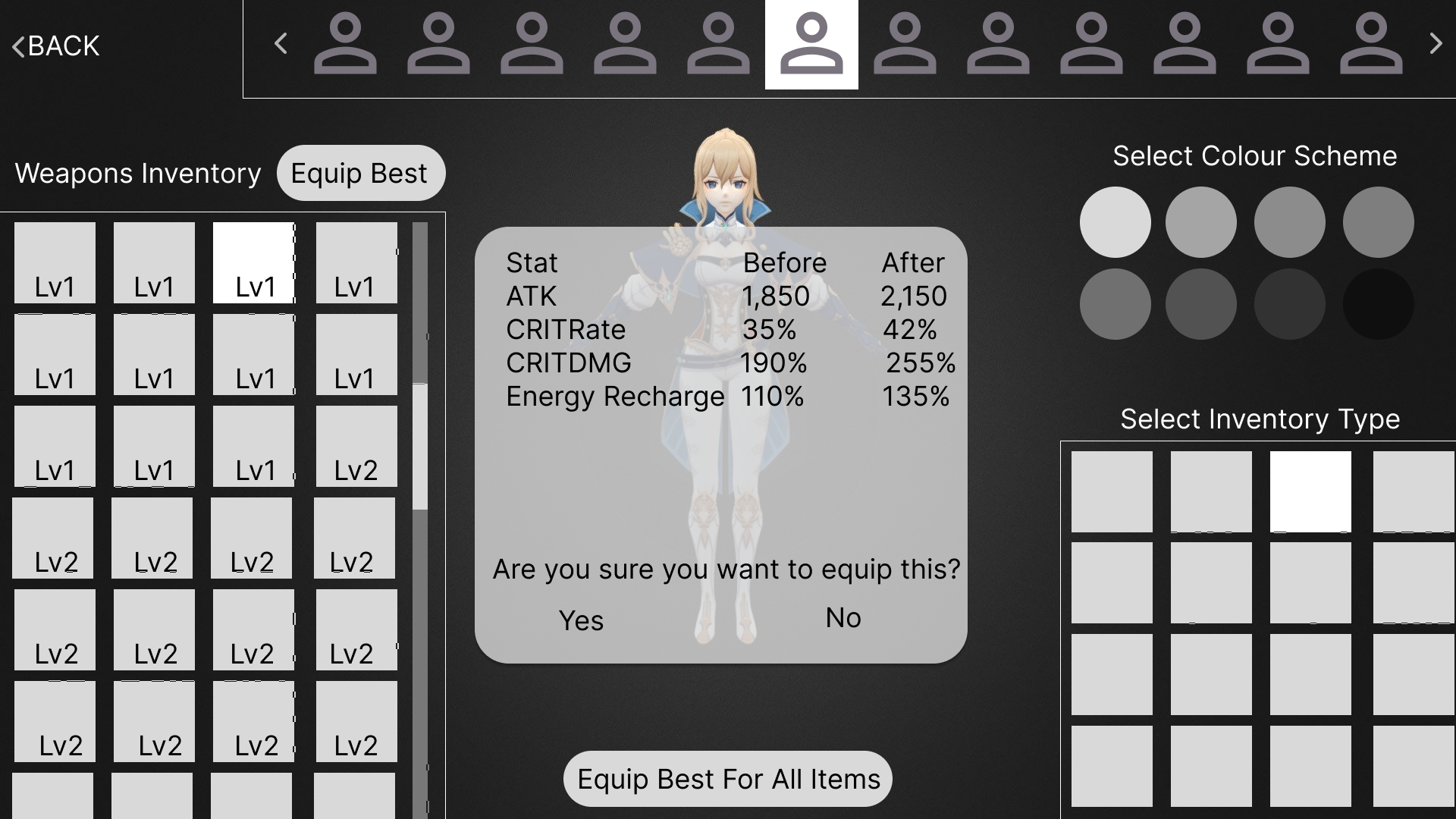
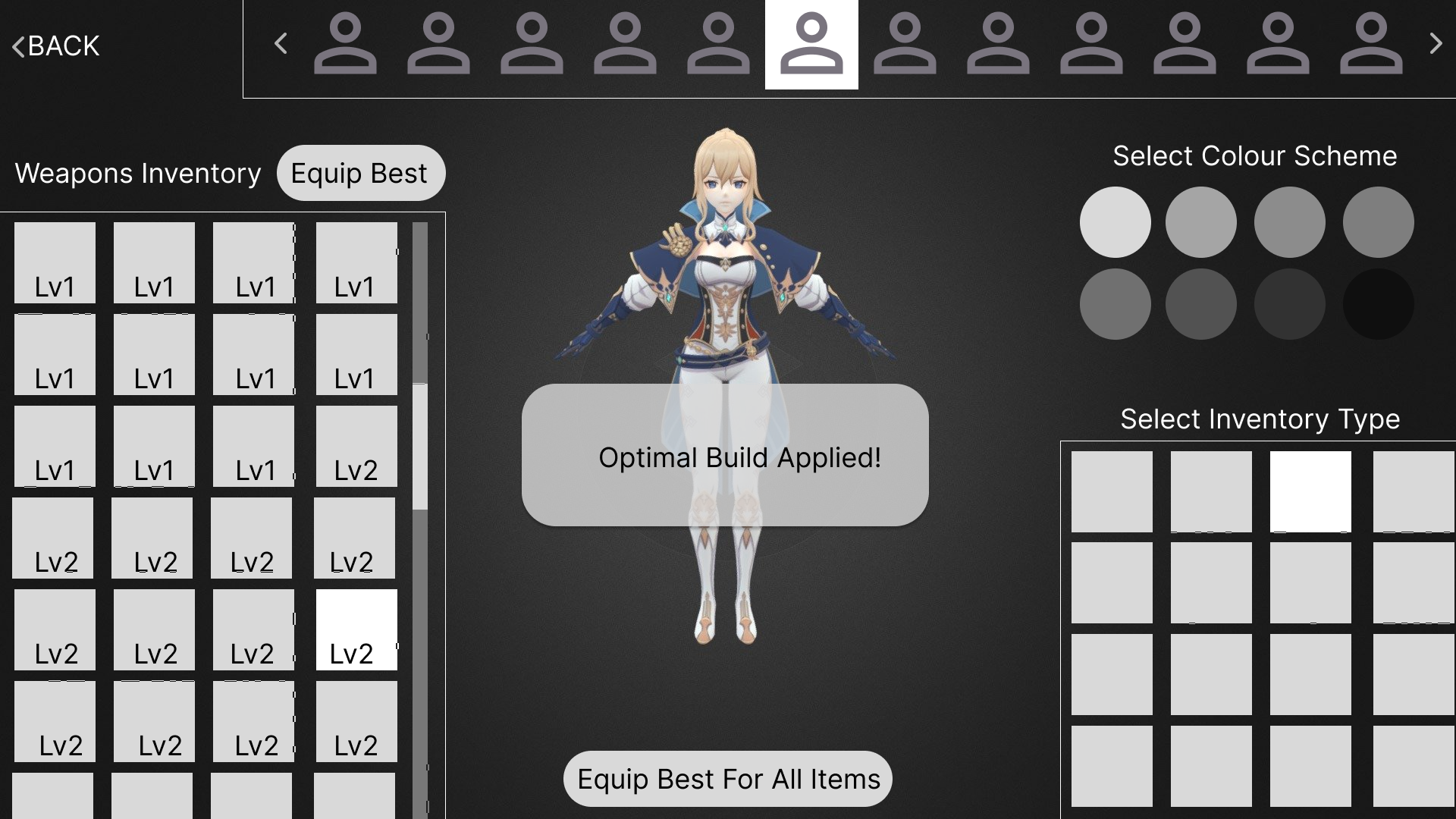
One-Click Optimal Build
Of course, here is a small text explaining how the "One-Click Optimal Build" feature works.
The feature works by allowing the player to press a single "Equip Best" button on the character screen. The system then calculates the strongest build from the player's available items and presents a simple "Before vs. After" comparison screen showing the changes to key stats
Case Study 3: Enhancing Quest Management (Final Portfolio)
Applying the lessons from the retention analysis, this proposal tackles another major friction point in Genshin Impact: an unwieldy quest log that leads to inefficient discovery and high cognitive load.
Proposed Solution: Quest Filters & Search Bar
Two key features are proposed for the quest and battle pass menus: Regional Filters and a Search Bar.
- Regional Filters: A "Nation Tab" system allows players to filter quests by region (e.g., Mondstadt, Liyue). This reduces cognitive load by hiding irrelevant information and helps players plan more efficient, geographically-focused gameplay sessions.
- Search Bar: A search function allows players to instantly find any quest by typing a keyword (NPC name, location, item), eliminating frustrating manual scrolling.
UI Mockups for the search and filter features

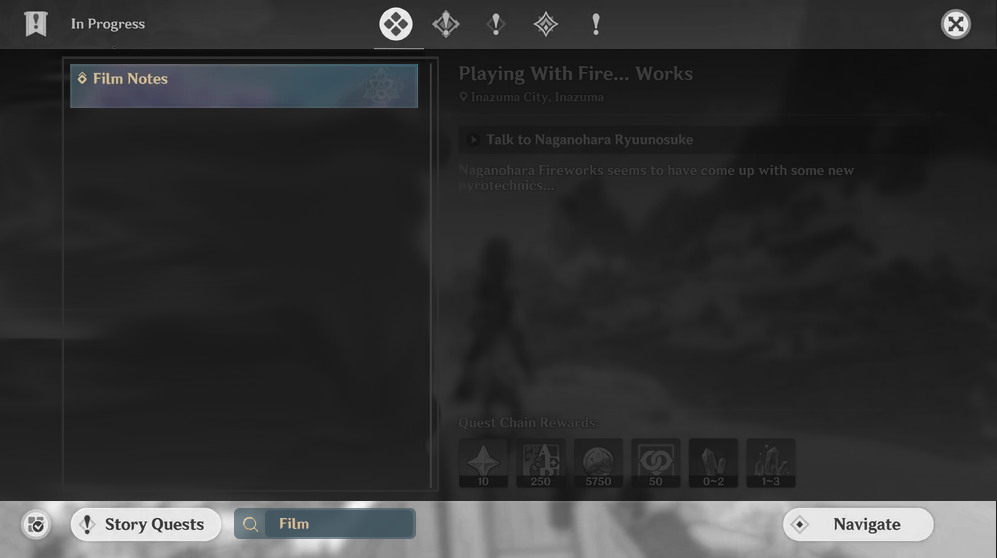
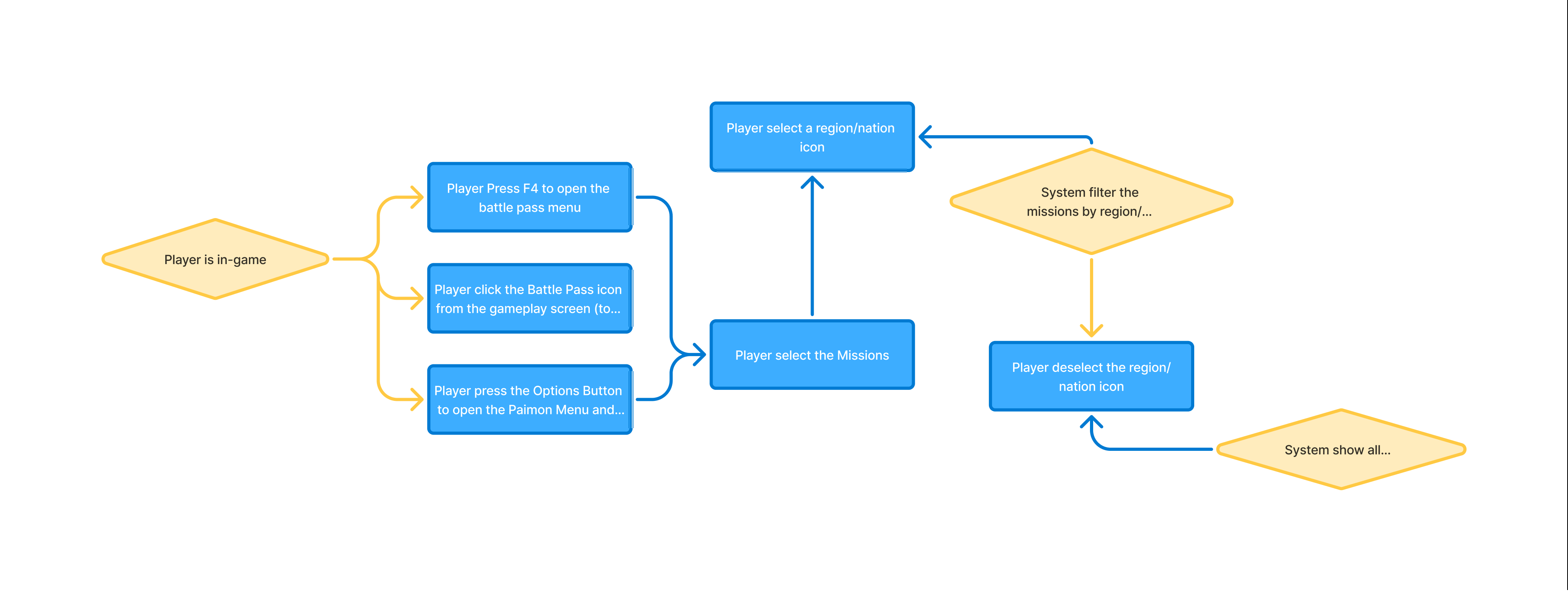
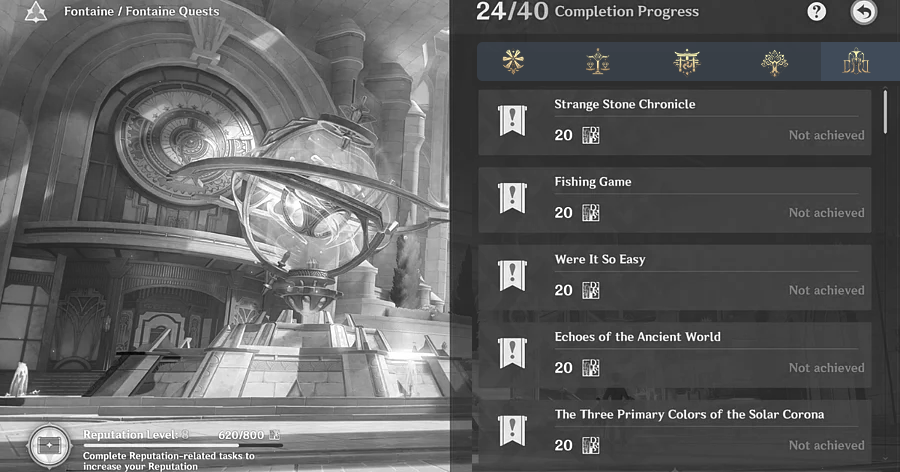
Search Filter For Quests
Battle Pass Missions Search By Region/Nation
Case Study 3: D1 Retention Analysis & Key Findings
Key Pain Point: Cognitive Overload
- Genshin Impact: Within the first hour, players are inundated with numerous complex menus, currencies, and meta-systems (Gacha/Wish, Events, etc.) with little context
. This detracts from the core joy of exploration and makes the game feel like "homework" . - Call of Duty: Mobile: The new player experience is hampered by early exposure to advanced systems like killstreaks, loadout customization, and the battle pass before players have mastered the core combat loop
. This flood of information interrupts the seamless flow of action and creates confusion .
Proposed Solution: Staggered Onboarding
New Embed
Embed caption.
New Embed
Embed caption.
Outcome / Results
Analytical Findings: The analysis of the new player journey revealed two primary findings:
- A Key Problem: The Day 1 experience in both Genshin Impact and Call of Duty: Mobile suffers from "Cognitive Overload," where new players are overwhelmed by an early onslaught of complex systems and menus
- - A Key Strength: Both games possess a powerful core experience—satisfying combat in CoD:M and a sense of wonder and exploration in Genshin Impact—that is a critical asset for player retention
Proposed Solutions & Deliverables: The project resulted in several fully-conceptualized feature proposals designed to mitigate the identified problems:
- - Quest Management Tools: To address the inefficient quest log in Genshin Impact, a Search Bar and Regional Filters were designed.
-"One-Click Optimal Build": A feature for Genshin Impact that automates character optimization to reduce friction for players.
Expected Results: The project defined clear quantitative goals to measure the success of these solutions, including a 5% increase in Day 1 retention for Genshin Impact and a 15-20% reduction in menu time for new players in Call of Duty: Mobile
Postmortem - Reflection on Challenges and Successes
- Problem Identification: The structured analysis of the player journey was highly effective at identifying clear, impactful pain points like "Cognitive Overload" and "Inefficient Quest Discovery"
- Strategic Prioritization: Using the Gold/Silver/Bronze methodology proved to be an excellent way to translate a long list of brainstormed ideas into a practical and strategic development plan. This ensures that even with potential scope cuts, a valuable solution (the Bronze Plan) is always ready.
- Grounded Solutions: The final design proposals are not just creative ideas; they are solutions directly grounded in the initial analysis, each one tailored to solve a specific, identified player problem.
What Could Be Improved / Next Steps
- Interactive Prototyping and User Testing: The project currently ends with static mockups. The clear next step would be to build interactive prototypes of the proposed features (like the quest filters and one-click build) and conduct formal usability testing with actual players to gather qualitative feedback and validate the design choices.
- Quantitative Validation: While the project defined success metrics, the next phase would involve implementing these features in a test environment to perform A/B testing. This would provide crucial quantitative data on their actual impact on player retention, engagement, and session length.
Lessons Learned
- The Primacy of the Core Loop: The D1 retention analysis reinforced how critical the initial gameplay experience is. A key lesson is that the core, enjoyable gameplay loop must be protected at all costs, especially from premature complexity that can overwhelm and deter new players.
- UX is a Balancing Act: Adding new features and content to a live-service game is a constant balancing act. This project was a practical lesson in how to improve quality of life and add functionality without increasing the cognitive load on the player base.
- A Structured Process Leads to Stronger Designs: Following a structured process—from analysis (player journey), to ideation (brainstorming), to prioritization (Gold/Silver/Bronze), and finally to design (flowcharts, mockups)—was invaluable. It ensures that the final solutions are well-researched, strategically sound, and built to solve real user needs.
